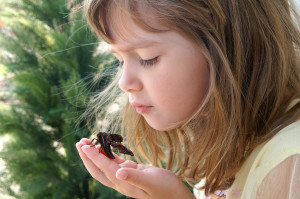 We have covered some of the basics of meditation with children (mindfulness meditation for small children). Here are a few more points.
We have covered some of the basics of meditation with children (mindfulness meditation for small children). Here are a few more points.
Have Realistic Expectations
With small children naturally occurring mindfulness moments can happen at the most wonderful AND the most inconvenient times. You may be in a hurry to get somewhere, but if your child stops for a few moments to stare at a bug, or splash water on a rainy day, (or any of the other many distractions that fascinate your particular child) let her have a minute or two before you rush her off. After all this is a natural form of mindfulness that is often thoroughly trained out of us by the time we reach adulthood. Patience.
On the other hand if you have arranged a meditation session for your child but she simply can not sit still for even a minute, try a little game or two to see if you can get better participation. Here are a few “games” to promote mindfulness –
- Blowing bubbles, watching them float, noticing the rainbow colours in the bubbles. This is a matter of watching and seeing with very little talking for either of you 🙂
- Smelling things – a flower, grass, dirt, clothes out of the dryer, food, crayons, even water. The point is to fit in a couple of minutes of just noticing the world around whenever the opportunity presents itself.
- If your child is chatterbox and just HAS to talk about what they are doing you may as well take it in stride and not try to force silence on her.
- Play a game of noticing all the sounds that are around (birds chirping, siblings talking, clock ticking, the wind in the trees)
- Touching things and noticing the textures (soft, hard, squishy, rough, smooth)
A good idea for an older child who is fidgety is to set a timer so they can see for themselves how long they have been meditating for.
Start small, 1 or 2 minutes for a very young child and 3 – 5 minutes for an older elementary school age child. You know your own child, just how long do you think he can sit still?
Encourage Discussion
Ask your child what she noticed or felt when engaged in the meditation, at the same time don’t be too surprised if she doesn’t have many words to describe it, the areas in the brain associated with language are pretty quite during meditation.
Guidance
- Make sure your child knows there is no right or wrong way to do the meditation.
- Frequency bring results much the same as with exercise. Results come from repetition.
- Find ways to make the experience enjoyable.
- Perhaps setting aside a particular quite spot with a comfy pillow or two.
- Perhaps a reward if that is a common form of approval in your family.
- For older children try a breathing exercise with them.
- Encourage them to try their best to relax and focus on their breathing.
- Let your child know that it is normal to have thoughts pop into her head, and that when it happens to just go back to focusing on her breathing.
- When appropriate instruct your child to keep her eyes closed during meditation. Explain that keeping the eyes closed makes it easier to focus on the meditation because there are not as many distractions.
- Again, expect some fidgeting. Fidgeting is common even for adults 🙂
- Know that with practice they will be able to sit still longer with both you AND your children enjoying the benefits of meditation.
To your health!
